南京理工大学-陆一飞老师作业作业-翻译英文文献
- 格式:pdf
- 大小:287.99 KB
- 文档页数:6
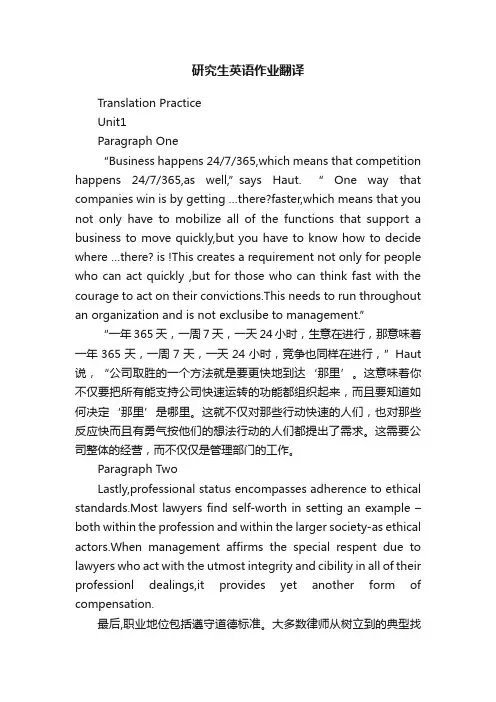
研究生英语作业翻译Translation PracticeUnit1Paragraph One“Business happens 24/7/365,which means that competition happens 24/7/365,as well,”says Haut. “ One way that companies win is by getting …there?faster,which means that you not only have to mobilize all of the functions that support a business to move quickly,but you have to know how to decide where …there? is !This creates a requirement not only for people who can act quickly ,but for those who can think fast with the courage to act on their convictions.This needs to run throughout an organization and is not exclusibe to management.”“一年365天,一周7天,一天24小时,生意在进行,那意味着一年365天,一周7天,一天24小时,竞争也同样在进行,”Haut 说,“公司取胜的一个方法就是要更快地到达‘那里’。
这意味着你不仅要把所有能支持公司快速运转的功能都组织起来,而且要知道如何决定‘那里’是哪里。
这就不仅对那些行动快速的人们,也对那些反应快而且有勇气按他们的想法行动的人们都提出了需求。
这需要公司整体的经营,而不仅仅是管理部门的工作。
Paragraph TwoLastly,professional status encompasses adherence to ethical standards.Most lawyers find self-worth in setting an example –both within the profession and within the larger society-as ethical actors.When management affirms the special respent due to lawyers who act with the utmost integrity and cibility in all of their professionl dealings,it provides yet another form of compensation.最后,职业地位包括遵守道德标准。
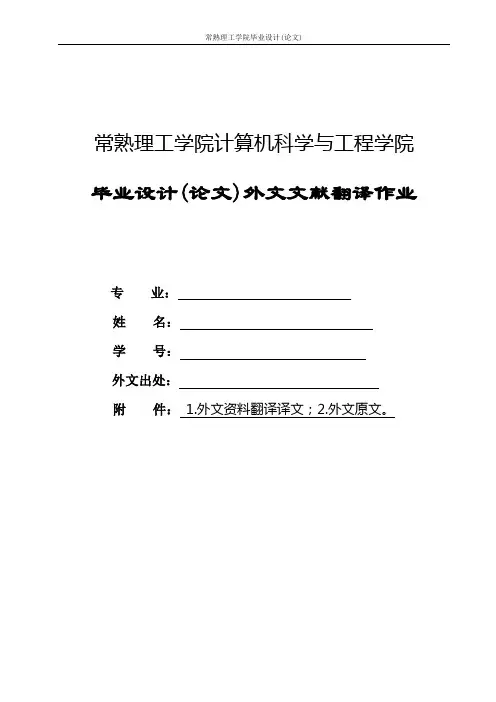
常熟理工学院计算机科学与工程学院毕业设计(论文)外文文献翻译作业专业:姓名:学号:外文出处:附件: 1.外文资料翻译译文;2.外文原文。
附件1:外文资料翻译译文计算机网络新技术摘要21世纪是一个信息时代的经济,计算机网络技术是这个时期的代表技术,以非常快的、具创造性得不断地发展,并将深入到人民群众的工作,生活和学习中。
因此,控制这种技术看起来似乎具有很重要的意义。
现在,我主要是采用新技术的几种网络技术在现实生活的应用。
关键字因特网数字证书数字银包网格存储 3G1.前言互联网满36岁,仍然是一个进展中的工作。
36年后在加州大学洛杉矶分校的计算机科学家使用15英尺的灰色电缆连接两台笨重的电脑,测试了一种在网络上新的数据交换的方式,这将最终成为互联网依然是一个在取得进展的工作。
大学的研究人员正在试验如何提高网络容量和速度。
编程人员正在设法为网页注入更多的智能。
并正在进行重新设计网络以减少垃圾邮件(垃圾邮件)和安全麻烦的工作。
与此同时威胁织机:批评人士警告说,商业,法律和政治压力可能会阻碍一些使互联网发展到今天的创新的类型。
斯蒂芬克罗克和温顿瑟夫属于1969年9月2日研究生加入的加州大学洛杉矶分校斯莱昂兰罗克教授工程实验室的团体,作为位无意义的测试数据两台计算机之间默默流动。
到第二年的1月,其他三个“节点”加入到了这个网络。
然后是电子邮箱,几年之后,在七十年代后期一个所谓的核心通信协议即TCP / IP 协议,在80年代域名系统和在1990年万维网-现在的第二个最流行的应用背后电子邮件出现了。
互联网的扩大,超出其最初的军事和教育领域延伸到了企业和全球的家庭中。
今天,克罗克仍然为互联网工作,为协作设计更好的工具。
作为互联网管理机构的安全委员会主席,他正试图保卫系统的核心处理免受来自外部的威胁。
他认识到,他帮助建立的互联网工作远未完成,而这些改变是在商店,以满足多媒体日益增长的需求。
网络供应商现唯一的“最佳努力”是在提供的数据包上。
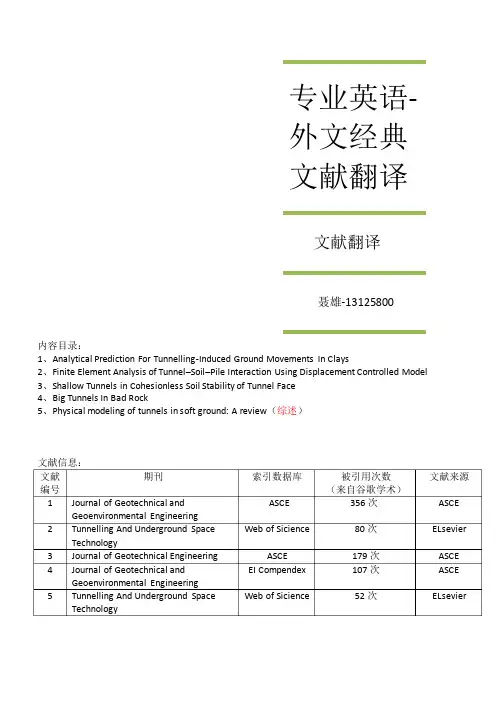
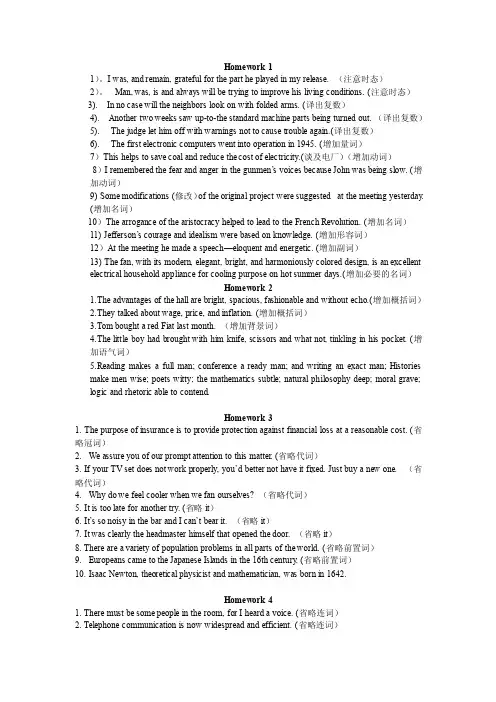
Homework 11)。
I was, and remain, grateful for the part he played in my release. (注意时态)2)。
Man, was, is and always will be trying to improve his living conditions. (注意时态)3). In no case will the neighbors look on with folded arms. (译出复数)4). Another two weeks saw up-to-the standard machine parts being turned out. (译出复数)5). The judge let him off with warnings not to cause trouble again.(译出复数)6). The first electronic computers went into operation in 1945. (增加量词)7)This helps to save coal and reduce the cost of electricity.(谈及电厂)(增加动词)8)I remembered the fear and anger in the gunmen’s voices because John was being slow. (增加动词)9) Some modifications (修改)of the original project were suggested at the meeting yesterday.(增加名词)10)The arrogance of the aristocracy helped to lead to the French Revolution. (增加名词)11) Jefferson’s courage and idealism were based on knowledge. (增加形容词)12)At the meeting he made a speech—eloquent and energetic. (增加副词)13) The fan, with its modern, elegant, bright, and harmoniously colored design, is an excellentelectrical household appliance for cooling purpose on hot summer days.(增加必要的名词)Homework 21.The advantages of the hall are bright, spacious, fashionable and without echo.(增加概括词)2.They talked about wage, price, and inflation. (增加概括词)3.Tom bought a red Fiat last month. (增加背景词)4.The little boy had brought with him knife, scissors and what not, tinkling in his pocket. (增加语气词)5.Reading makes a full man; conference a ready man; and writing an exact man; Historiesmake men wise; poets witty; the mathematics subtle; natural philosophy deep; moral grave;logic and rhetoric able to contend.Homework 31. The purpose of insurance is to provide protection against financial loss at a reasonable cost. (省略冠词)2. We assure you of our prompt attention to this matter. (省略代词)3. If your TV set does not work properly, you’d better not have it fixed. Just buy a new one.(省略代词)4. Why do we feel cooler when we fan ourselves? (省略代词)5. It is too late for another try. (省略it)6. It’s so noisy in the bar and I can’t bear it. (省略it)7. It was clearly the headmaster himself that opened the door. (省略it)8. There are a variety of population problems in all parts of the world. (省略前置词)9. Europeans came to the Japanese Islands in the 16th century. (省略前置词)10. Isaac Newton, theoretical physicist and mathematician, was born in 1642.Homework 41. There must be some people in the room, for I heard a voice. (省略连词)2. Telephone communication is now widespread and efficient. (省略连词)3. This was a masterly appointment. (省略动词)4. These developing countries cover vast territories, encompass a large population and abound in natural resources. (省略动词)5. Stainless steels possess good hardness and high strength. (省略动词)6. It is desirable that the meeting should be held as soon as possible.7. We have tested 200 types of cloth, none of which is completely waterproof.8. We had learned a lot from the workers and technicians.9. The cessation of the present restrictions cannot be made.10. Their respective destiny are becoming increasingly interdependent. 11. Before the night was far advanced, they began to move against the enemy.12. One must make painstaking effort before one could succeed in mastering a foreign language.13. I can finish the work so long as you give me time.14. We are looking forward with interest to you reply.Homework 5Everyone has got two personalities-the one that is shown to the world and the other that is secret and real. Y ou don't show your secret personality when you're awake because you can control your behavior, but when you're asleep, your sleeping position shows the real you. In a normal night, of course, people frequently change their position. The important position is the one that you go to sleep in.If you go to sleep on your back, you're a very open person. Y ou normally trust people and you are easily influenced by fashion or new ideas. Y ou don't like to upset people, so you never express your real feelings. Y ou're quite shy and you aren't very confident.Homework 6越来越多受英文教育的海外华人父母,已经认识到孩子在掌握不可或缺的英文的同时,也通晓中文的重要性。
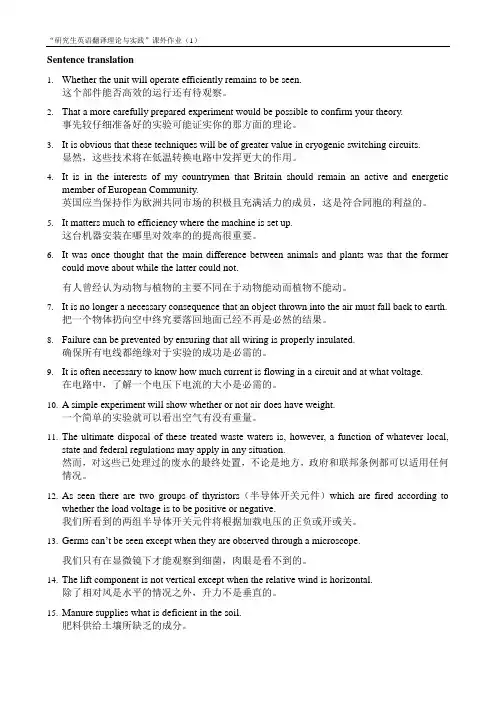
Sentence translation1.Whether the unit will operate efficiently remains to be seen.这个部件能否高效的运行还有待观察。
2.That a more carefully prepared experiment would be possible to confirm your theory.事先较仔细准备好的实验可能证实你的那方面的理论。
3.It is obvious that these techniques will be of greater value in cryogenic switching circuits.显然,这些技术将在低温转换电路中发挥更大的作用。
4.It is in the interests of my countrymen that Britain should remain an active and energeticmember of European Community.英国应当保持作为欧洲共同市场的积极且充满活力的成员,这是符合同胞的利益的。
5.It matters much to efficiency where the machine is set up.这台机器安装在哪里对效率的的提高很重要。
6.It was once thought that the main difference between animals and plants was that the formercould move about while the latter could not.有人曾经认为动物与植物的主要不同在于动物能动而植物不能动。
7.It is no longer a necessary consequence that an object thrown into the air must fall back to earth.把一个物体扔向空中终究要落回地面已经不再是必然的结果。
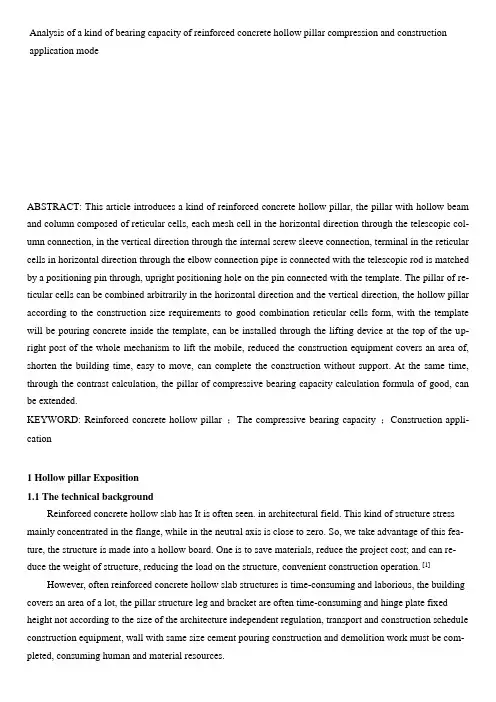
Analysis of a kind of bearing capacity of reinforced concrete hollow pillar compression and construction application modeABSTRACT: This article introduces a kind of reinforced concrete hollow pillar, the pillar with hollow beam and column composed of reticular cells, each mesh cell in the horizontal direction through the telescopic col-umn connection, in the vertical direction through the internal screw sleeve connection, terminal in the reticular cells in horizontal direction through the elbow connection pipe is connected with the telescopic rod is matched by a positioning pin through, upright positioning hole on the pin connected with the template. The pillar of re-ticular cells can be combined arbitrarily in the horizontal direction and the vertical direction, the hollow pillar according to the construction size requirements to good combination reticular cells form, with the template will be pouring concrete inside the template, can be installed through the lifting device at the top of the upright post of the whole mechanism to lift the mobile, reduced the construction equipment covers an area of, shorten the building time, easy to move, can complete the construction without support. At the same time, through the contrast calculation, the pillar of compressive bearing capacity calculation formula of good, can be extended.KEYWORD: Reinforced concrete hollow pillar ;The compressive bearing capacity ;Construction appli-cation1 Hollow pillar Exposition1.1 The technical backgroundReinforced concrete hollow slab has It is often seen. in architectural field. This kind of structure stress mainly concentrated in the flange, while in the neutral axis is close to zero. So, we take advantage of this fea-ture, the structure is made into a hollow board. One is to save materials, reduce the project cost; and can re-duce the weight of structure, reducing the load on the structure, convenient construction operation. [1] However, often reinforced concrete hollow slab structures is time-consuming and laborious, the building covers an area of a lot, the pillar structure leg and bracket are often time-consuming and hinge plate fixed height not according to the size of the architecture independent regulation, transport and construction schedule construction equipment, wall with same size cement pouring construction and demolition work must be com-pleted, consuming human and material resources.1.2 The content and structureTechnical problems of the novel hollow pillars to be solved, is to address the above problemsof technol-ogy, provides a reinforced concrete hollow pillar, the beam and column composed ofreticular cells, each mesh cell in the horizontal direction through the telescopic column connection, in the vertical direc-tion through the internal screw sleeve connection, terminal in the reticular cell level the direction ofthe connecting pipe through the elbow is connected with a telescopic rod with, through a positioningpin through the positioning holes and the pincolumn template on the ground, reticular cells canbe combined arbitrarily in the horizontal direction and the vertical direction, the hollow pillar accordingto construction requirements tothe combination of good mesh size cells form, with the template willbe pouring concrete inside the template, you can through the installation of the lifting device at the top of the upright postof the whole mechanism to lift the mobile, reduced the construction equipment covers an area of, shorten the plumber, mobile convenience, good equipment can be com-pleted withoutsupport construction[2]. In order to solve the technical problem, the technical proposal of the utility model is used: including the mesh cell, a telescopic column, a telescopicrod, liftingdevice, template, double connecting column, each mesh cell horizontally connected with the teles-copic column screw thread, and each mesh cell in the vertical direction and the internal thread casingthread connection; double column connection one end is connected with a telescopic rod, the other end is connected with the elbow pipe thread connection; elbow connection pipe in the horizontal direction is con-nected with the reticular cell threads; hoisting device connected through the internal thread bushing andthe reticular cell thread in the vertical direction; each template and each mesh cell in the horizontal direc-tion pin.Reticular cell comprises two cross beams and two columns and two beams of two upright posts in the ho-rizontal direction and the vertical direction of the vertical welding; the middle part of each column inthe perpendicular to the reticular cell plane is provided with a positioning hole and the positioning hole and the positioning pin matched with the through the column of the template for the pin connection. The lift-ing device comprises a davit and rings,the rings through the upper end and the lower end of the davit davit, the upper end of the upright post connecting thread[3].Compared with the prior art, the utility model has the following advantag-es: splicing hollowpillar 1, reticular cell according to the construction size requirements from themain regulatingreticular cells assembled into the mold surface, match template can be built in accordance with construction dimensions of the mechanism; 2, lifting device is arranged on the upper end of the vertical beam, can be poured with a size of the wall without disassembly, directly through the mechanism ofintegral lifting, the utility model is positioned to the construction ofthe specified location, to avoid the need to disassemble each time you use the trouble, and saves time and area, saves construction cost.1.3 Hollow pillar structure design2 Analysis of bearing capacity of hollow pillar2.1 Axial compressive capacity of the hollow pillarFor concrete columns, experiments show that, when the increase of slenderness ratio, the destruction shape hollow pillar by pillar of material damage will be gradually to the instability and failureof transformation. Thus, according to the actual experiment, the calculation of the axial compressive bearing capacity, the need to introduce a characterization l θ,which characters the slenderness ratio thinner than the reduction coefficient ,to calculate the axial compressive bearing capacity of the hollow pillar :l N .I.e.:2220()22()4l l l y c y D d t N N b t f f k f D πθθπ⎡⎤-==++⎢⎥⎣⎦[4]Among :Expressions for the l θ:1l θ=-2.2 Analysis and calculation of verification and comparisonBy comparing the data of the actual experiment and literature, we can know the bearing capacity of the hollow pillar compression. Through the long column specimen test data of [7],the results were compared with the above formula. As shown in table 1.table 1 Axial compression hollow long column specimen test results contrast calculation tableis accurate. The compressive strength of hollow pillar with bearing capacity requirements[5].3 Hollow pillar construction application methodsWith 1.3 illustrations, to this kind of reinforced concrete hollow pillar do construction on the applica-tion[6].Hollow pillar includes a mesh cell 1, telescopic column 2, telescopic rod 3, lifting 4, 5 template, double connection column 6, each mesh cell on a horizontal connection with telescopic column 2 thread, and each 7 screwed on the mesh cell 1 in the vertical direction and the inner threaded sleeve; column 6 is connected one end of the stud 3 is connected to the telescopic rod, and the other end is connected with the elbow pipe 8 threaded connection; elbow connection pipe 8 in the horizontal direction a threaded connection with the mesh cell; lifters 4 7 1 through the inner threaded sleeve threaded connection with the mesh cell in the vertical di-rection[7]; each template 5 with each mesh cell 1 in the horizontal direction pinned ; mesh cell 1 comprises two beams 9 and two uprights 10, the two beams 9 and 10 vertically welded on the two columns in the vertic-al direction in the horizontal direction; the middle of each column 10 is perpendicular to the mesh unit opened a positioning hole 11, the positioning hole 11 and the positioning pin 12 through the uprights with 10 pairs of template 5. pinned on a plane lattice; lifting davit 4 includes 13 and 14 rings, 14 rings throughout the 13 upper davits, davit the lower end of the upper end of the column 10 13 threaded connections[8].When it is used, determined according to the size of building construction size of the institution, through the mesh of the beam on a 9-cell connection telescopic column 2, by adjusting the telescopic two dimensions of this body in the longitudinal direction, and on through the mesh cell 1 column 10, column 10 is connected internally threaded bushing 7 the height adjustment of the mechanism in the vertical direction, through the end of the tube 8 is connected to the elbow connector beams 9, elbow connection pipe 8 through the connection stud and the telescopic rod 6 connecting posts 4 , this means adjusting the size in the width direction, without the support frame and other auxiliary equipment, construction cost savings, reducing the footprint, the tem-plate 5 through the positioning pins 12 through the positioning holes 10 on the post 11, the template 5 pin connected to the column 10, thus completing the rapid build of the body; when construction needs another pouring concrete block wall, it will be installed in the top 4 lifting columns 10, 13 and the inner davit tighten the threaded bushing 7, the rope socket 14 on the rings, lifting in the vertical direction of the body, move it to a location designated construction, complete fast-moving work, no longer separate structures, each use to avoid the trouble of disassembly required, saving hours of work and footprint, saving the cost of construction, to the design effect[9] [10].4 Epilogue1. This kind of reinforced concrete hollow pillar can basically solve some of the problems of the prior art, is simple to operate, reducing the amount of construction and so on.2. The types of reinforced concrete hollow pillar has more good compression capacity, to meet the con-struction requirements of the force. While the bearing capacity of the hollow pillar provides a new calculation formula.3. The kind of hollow concrete pillar construction process is simple, no longer separate structures, each use to avoid the trouble of disassembly required, saving hours and footprint, save construction cost, to the de-sign effect[11].1PREFERENCES, SYMBOLS AND UNITS-[1] Song Pu "modern concrete basic theory and engineering applications" [M]. China Architectural Press 2008-[2] for ultimate, Song Pu "reinforced concrete structure" Mechanical Press [M] .2004-[3] Wang Licheng, for ultimate, Pu Song "Hydraulic Reinforced Concrete Structures" Mechanical Press [M] .2008-[4] "reinforced concrete structure design specifications" [S].GB50010-2010-[5] MIYAKI SATOSH. Evalution formular of compressive strength of centrifugal concrete filled steel square tubular columns[J]. Kozo Kogaku Ronbunshu.B.Journal of Structural Engineering. B),1997,43B:581-586.-[6] MIYAKI SATOSH. Ultimate strength and deformation capacity of centrifugal concrete filled steel square tubular columns[J].Nippon Kenchiku Gakkai Kozokei Ronbunshu (Journal of Structural and Construction Engineering)(Transactions of AIJ),1997(500):105-112.-[7] O'Shea M.D.,Bridge R.Q.,Test on circular thin-walled steel tubes filled with medium and high strength concrete[J]. Research Report- University of Sydney, Department of Civil Engineering,1997(755):1- 118.-[8] Zhong Shantong, Xu Guolin, hollow concrete filled steel tube under axial compression performance [J] Journal of Harbin Institute of Technology, 2006,9 (38): 1479-1503.-[9] Wang Hongwei, IN STEEL experimental study of hollow concrete filled steel tube long columns under axial compression [J]. Industrial buildings, 2006,36 (12): 69-73.-[10] Cai Shaohuai modern steel concrete structures [M]. Beijing: China Communications Press, 2003.-[11] Dou Haojie, Xiao Peng, Liu Lili. Prevention and Treatment of large diameter hollow cylinder surface defects in concrete [J]. Real Estate Guide, 2014, (2)2浅析一种钢筋混凝土空心支柱抗压承载力与施工应用方式[摘要]文章介绍了一种钢筋混凝土空心支柱,该空心支柱采用横梁与立柱组成网状单元格,每个网状单元格在水平方向上通过伸缩柱连接,在竖直方向上通过内螺纹套管连接,在网状单元格水平方向的末端通过弯头连接管与伸缩杆配合连接,通过定位销穿过立柱上的定位孔与模板销接。
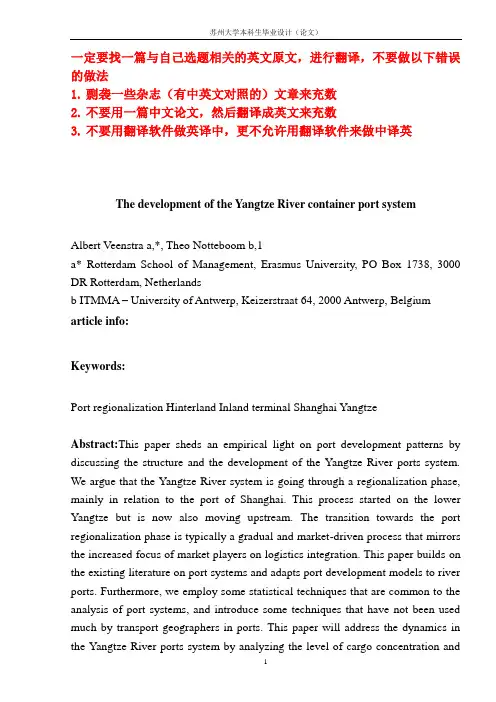
一定要找一篇与自己选题相关的英文原文,进行翻译,不要做以下错误的做法1.剽袭一些杂志(有中英文对照的)文章来充数2.不要用一篇中文论文,然后翻译成英文来充数3.不要用翻译软件做英译中,更不允许用翻译软件来做中译英The development of the Yangtze River container port systemAlbert Veenstra a,*, Theo Notteboom b,1a* Rotterdam School of Management, Erasmus University, PO Box 1738, 3000 DR Rotterdam, Netherlandsb ITMMA – University of Antwerp, Keizerstraat 64, 2000 Antwerp, Belgium article info:Keywords:Port regionalization Hinterland Inland terminal Shanghai YangtzeAbstract:This paper sheds an empirical light on port development patterns by discussing the structure and the development of the Yangtze River ports system. We argue that the Yangtze River system is going through a regionalization phase, mainly in relation to the port of Shanghai. This process started on the lower Yangtze but is now also moving upstream. The transition towards the port regionalization phase is typically a gradual and market-driven process that mirrors the increased focus of market players on logistics integration. This paper builds on the existing literature on port systems and adapts port development models to river ports. Furthermore, we employ some statistical techniques that are common to the analysis of port systems, and introduce some techniques that have not been used much by transport geographers in ports. This paper will address the dynamics in the Yangtze River ports system by analyzing the level of cargo concentration andthe degree of inequality in operations of the container ports. The paper also assesses observed differences in development of ports in different areas along the river (upstream/ downstream) and reflects on the role of ownership structures in shaping regional load centre networks.1.IntroductionThe Yangtze River plays an important role in the strategy to develop the central and western provinces of China. Previous research (see e.g. Veenstra et al., 2008; Notteboom, 2007; Rimmer and Comtois, 2009) has shown that there is a great potential for growth of especially Yangtze River container shipping. At present, however, the current system of container ports and shipping networks exhibits considerable overcapacity, since the growth of container flows seems to lag behind the growth of the (port) infrastructure and shipping capacity.This paper aims to investigate the structure and development of the container river port system along the Yangtze. Little is known about these ports, as compared to the Chinese seaports, that have been studied by various authors (see, for instance, Liu et al., 2006; Cullinane et al., 2005), and inland ports in other parts of China and the world, see Wang and Slack (2000) on the Pearl River Delta, Notteboom and Konings (2004) for river ports on the Rhine and Frémont et al. (2009) for river ports in France. Lammie (2008) contains much in terms of descriptive information on the Yangtze River Ports, but very little analysis has been presented to data.Some of the main questions that deserve answers concerning the Yangtze River ports are: what is the level of concentration in the Yangtze container port system, and what is the degree of inequality between the container river ports? Are there differences in development of ports in different areas along the river (upstream/downstream) and does the type of ownership play a role?The paper is organized as follows. We first introduce the most relevant characteristics of the port system along the Yangtze River. We then develop the analytical framework for an inland port system.Subsequently, we present the analysis of concentration (Section 4), cluster analysis (Section 5), and the investigation of the role of outside ownership (Section 6). We finish with ourconclusions.2. The Yangtze River2.1. Situation plan of the Yangtze River Fig. 1 shows the position of the Yangtze River in China.Fig. 1. Map of the Yangtze River.Source: _Solid Software Pty., Ltd. (permission to use this map was kindly granted by Solid Software Pty., Ltd., Australia).The total length of the Yangtze River is about 6300 km. About 2800 km of that is navigable for cargo vessels. This part of the river can be divided into three main reaches: the lower reach from Shanghai to Nanjing, the middle reach from Nanjing to Yichang (the container port that is nearest to the Three Gorges Dam) and the upper reach from Yichang to Yibin. The inland port city of Chongqing is located in the upper reach, and the city of Wuhan is located in the middle reach. Together with Nanjing and Shanghai, these four cities are the main cities along the Yangtze River. The river depth develops from 10.5 m in the delta area between Shanghai and Nanjing, around 5–6 m between Wuhu and Wuhan, about 4 m in the stretch between Fuling and Wuhan, to 2.5–3 m around Chongqing and less than 2 m beyond Lanjiatuo (which lies between Chongqing and Luzhou) (these are average winter figures, Changjiang Waterway Bureau, 2007). The water level between winter and summer can differ as much as 4 m on average, with muchlargerfluctuations around the average.2.2. Port overviewAn overview of the throughput of the main container ports along the Yangtze River is presented in Table 1. The river is characterized by a combination of large ports and very small ports. Some of the ports show substantial growth, while other river ports grow very little, or even decline somewhat. The latter are mostly small ports (e.g. Anqing Wulimiao) or ports that are being replaced by more modern facilities (e.g. Chongqing Jiulongpo, Nanjing International Container Terminal).From Table 1, it is clear that the bigger ports are all located in the lower reach. These ports facilitate the economic development that is still concentrated in the area around Shanghai, and these ports can receive coastal and deepsea vessels, which leads to much more traffic and growth opportunities than the upper and middle reach ports.Another observation that can be made is the concentration of relatively small ports in the middle reach: Chenglingji, Huangshi, Anqing, Tongling, Maanshan. Including Chizhou, four of these are in Anhui province, which is one of the poorer provinces of China. The weak position of Anhui on the international market (in sharp contrast to coastal provinces such as Zhejiang and Jiangsu) apparently reflects on the development of its container ports. Another reason is the apparent inability of the Anhui Provincial Government to control the development of port capacity and to concentrate on one large port (Wuhu).2 The reason that was given for this is that cities can apply directly to the national government for approval to develop a port. The provincial government has little influence in this process.Table 1 also contains information on the ownership of the ports/ terminals. In principle, from the mid-1980s, the ports were all owned by municipal authorities. Fairly quickly outside investors were attracted to ports in Wuhan (Wuhan Yangluo) in the 1980s and Changshu in 1994 (Lammie, 2008). Later many more ports and terminals attracted primarily Chinese investors, among them the Shanghai port operator SIPG (Shanghai International Port Group) and container shipping line COSCO. Ignoring the ports and terminals that are merely stock listed, in total 60%of the ports have outside ownership, representing 84% of total throughput. From this, one could infer outside investors seem to be attracted to the bigger terminals. This will be investigated in greater detail in a next section.It should be mentioned that throughput data on ports in China is notoriously unreliable. Reporting of throughput is not standardized, and some ports report throughput including empties, while other do not, and ports sometimes are not clear if they report containers or TEU. In addition, ports may consist of different container handling companies, some of which do not have a fixed association with a terminal. They hire space whenever there is a ship to handle, and this might be in a container terminal or in a general cargo or break bulk terminal. As a result, handling figures based on terminals or handling companies may not add up to a port’s total container throughput. In Shanghai, for instance, this gap may be as much as one million containers.In addition to throughput, capacity information is also available on most container terminals. This information is even less reliable than throughput information: for the larger ports (e.g. Nanjing and Taicang) two or more very different capacity figures circulate in public sources. As an illustration, Fig. 2 reports a comparison of cumulative capacity and throughput along the river. From the figure, it is clear that there is sufficient room for growth in all ports, and that Nanjing is one of the ports that is operating relatively close to capacity. Nanjing does have extensive expansion plans, as do almost all the other ports. Due to the unreliability of this data, we will not use it further in our analysis.We also present an overview of some of the technical dimensions of the container terminals along the Yangtze River. For all ports in Table 1, we have collected the number of cranes, the terminals themselves or other (Chinese) data sources. We have also estimated throughput for the period 2007–2010. These estimates are based on terminals’ own projections. Compared to growth rates in the past, this is a conservative estimate, although growth rates overall were declining. Table2 1Port throughput 2005–2010(in TEU); in order of location along the river.Source: Lammie (2008), port and terminal websites, various internet sources, personal communication. ‘(m)’ = minority stake, ‘ph1’ is phase 1.Fig. 2. Capacity-throughput comparison 2006.Source: Authors’ compilation.Table 2Note: 2008–2010 figures are based on reported expansion projects. # Stands for number, m is meter, m2 is square meter, TEU is 20 foot equivalent unit.The development of the average operational characteristics, as presented in Table 2, gives an impression of the dynamics of port development along the Yangtze River. Ports are getting bigger in terms of the number of cranes, number of berths, yard capacity and quay length. The year 2009, however, seems to represent a temporary slowdown in port development. In fact the only new ports in 2009 are the replacement of the old container port of Chenglingji by the new Songyanghu terminal, and the new but small Tongling container terminal. Berthing capacity in 2010 is not growing because it is calculated by multiplying maximum depth at the quay with maximum ship size. This measure increased primarily due to the addition of new terminals before 2010. In 2010, no new terminals were added. In 2010, the new Wuhu Cherry car and container terminal is planned to start operations, but on this terminal no operational information was available.Finally, it is worthwhile to analyze the liner service networks on the Yangtze River. The river services are primarily organized per navigation area (upper, middle and lower stretches), see Notteboom (2007). Line-bundling types of services are dominant with each service typically calling at three to four inland ports per rotation. Even in the load centre of Nanjing, end-to-end services represent less than one-third of all river services calling at the Lower Yangtze inland port. In other inland ports, line-bundling services have a market share of more than 80%. The only exceptions are found in the Upper Yangtze. End-to-end services are rare in the Middle Yangtze segment. There are no hub-andspoke structures for container transport in place on the Yangtze, although the market might be evolving towards large inland waterway hubs on the Lower Yangtze (particularly Nanjing and Taicang) with direct feeder connections to major transshipment hubs in East Asia such as Busan in South Korea and Shanghai’s Yangshan offshore terminal complex situated northeast of Hangzhou Bay.3. The analysis of an inland port system: conceptual framework and hypothesesA well-established body of literature exists on the development of seaport systems. A central theme to the study of port systems is the level of spatial and functional concentration and the analysis of the underlying factors that contributeto such concentration. Seminal papers on this issue include Ogundana (1970) and Taaffe et al. (1963) which portray an evolutionary pattern from scattered, poorly connected ports along the coastline to a main network consisting of corridors between gateway ports and major hinterland centres. Barke (1986) and Hayuth (1981) refer to rising pressures for deconcentration in port systems. Empirical research has demonstrated that some port systems and port ranges are getting more spatially concentrated while others are evolving to a more evenly distributed system, see e.g. Kuby and Reid (1992), Notteboom (1997, 2006), McCalla (1999), Lago et al. (2001), Rimmer and Comtois (2009) and Notteboom (2010).Notteboom and Rodrigue (2005) have added an additional phase to port development: the regionalization phase which links seaport system development to the development of inland ports and centres. The phase of regionalization takes the process of port development beyond the perimeter of the port and culminates in the development of regional load centre networks between seaports and inland ports. Port regionalization is thus strongly interrelated with the development and performance of associated inland networks that give access to cargo bases in the hinterland.The link between the structure and the development of the Yangtze River port system with the models on seaport system development is relevant for three reasons.First of all, we argue that the Yangtze River port system is affected by (de)concentration patterns at the side of the seaport system which feeds the river system with container cargo. Cargo growth in the seaport system obviously puts more pressure on hinterland networks. These hinterland networks adapt through corridor development. The combination of large deepsea volumes and massive intermodal corridors allows load centres to enlarge contestable hinterland areas, to create discontinuous hinterland areas and to intrude in the natural hinterland of rival ports (the so-called ‘island’ formation, see also Notteboom and Rodrigue, 2005). A river port system is to be considered as a corridor consisting of a set of continuous and discontinuous areas all positioned along a river or waterway (Fig.3). However, the Yangtze River case is much more complex than suggested by the generic conceptual model in Fig. 3. On the one hand, the development of theoffshore port of Yangshan, also managed by Shanghai, has triggered the development of feeder services between the Yangshan terminal complex and container terminals in Shanghai and Nanjing. On the other hand, while Shanghai is the main gateway feeding the container river port system along the Yangtze, there are other liner service configurations in place that bypass Shanghai/Yangshan. For example, Taicang in Jiangsu province has developed strong links to Busan, the most important transhipment hub in the Northeast Asia with a container volume of 13.4 million TEU in 2008 (compared to 28 million TEU for Shanghai). Taicang in this way competes with the pivotal role of Shanghai. These examples support the concept of ‘foreland-based regionalization’ as developed by Rodrigue and Notteboom (2010).Fig. 3. A river port system connected to a seaport system.Source: Adapted from Notteboom and Rodrigue (2005).Secondly, we argue that the Yangtze River system is affected by a regionalization phase, mainly, but not exclusively, in relation to the port of Shanghai. This process started on the lower Yangtze but is now moving upstream. The transition towards the port regionalization phase is typically a gradual and market-driven process that mirrors the increased focus of market players on logistics network integration. As we will demonstrate later in this paper, the inland strategy of terminal operator SIPG (Shanghai International Port Group) proved to be instrumental for the observed regionalization and the associated creation of a regional load centre network in relation to the port of Shanghai.Thirdly, it is interesting to analyze whether the concentration mechanisms,observed in seaport systems, also work in a similar way in river port systems. We argue that the concentration patterns in river port systems do not necessarily follow the same principles as in seaport systems. A first difference between river port systems and seaport systems lies in the interconnection with other nodes in the wider network. Seaports are connected to a large set of overseas seaports, while inland port systems are typically fed by only a few large gateway ports. For example, the Rhine river in Europe is highly dependent on the main container ports Rotterdam and Antwerp (see Notteboom and Konings, 2004), the Seine river ports in France rely primarily on maritime container flows transshipped in Le Havre and the ports in the basin such as Lyon and Dijon are highly dependent on the Mediterranean seaport of Marseille (see Frémont et al., 2009). Similarly the Yangtze River port system relies mainly on Shanghai and to a lesser extent also on Ningbo and the connections of the lower reach ports (Taicang, Nanjing, Zhangjiagang, among others), with nearby countries such as South Korea and Japan, for containerized cargo volumes. A second difference between river port systems and seaport systems lies in the spatial structure. A second difference between river port systems and seaport systems lies in the spatial structure. The container flows on the Yangtze River have a treelike structure with limited or no lateral connections between the branches. Furthermore, the nautical accessibility of inland ports gradually diminishes towards the upstream ports, while the vessel capacity is restricted and the fleet is not very homogeneous. Because of the deep water conditions in the lower reaches and the shipping connections with nearby countries, vessels plying the lower reaches are often short sea vessels. These short sea ships typically have higher unit costs than the inland vessels used on the Yangtze due to their elevated capital costs, higher bunker costs per load unit and more strict manning requirements. These elements favour the use of line-bundling systems and make hub-and-spoke service networks less obvious. In a seaport system, neighbouring ports sharing the same coastline can have largely different draft profiles. As a result, a port with a favourable draft can potentially become bigger then adjacent ports simply because the port can accommodate larger vessels (concentration). In an inland port system, it is more likely that adjacent ports will have a similar draft profile. Thus, differences in nautical access generally do not play a decisive role as drivers for cargo concentration at a local level (i.e. amongadjacent inland ports in the same navigation area).......From:Albert Veenstra ,Theo Notteboom , The development of the Yangtze River container port system,Journal of Transport Geography 19 (2011) 772–781长江流域集装箱港口系统的发展艾伯特·凡斯塔,a*;西欧·诺特伯,b1a*.荷兰鹿特丹市伊拉斯姆斯大学,邮政信箱1738,3000号。
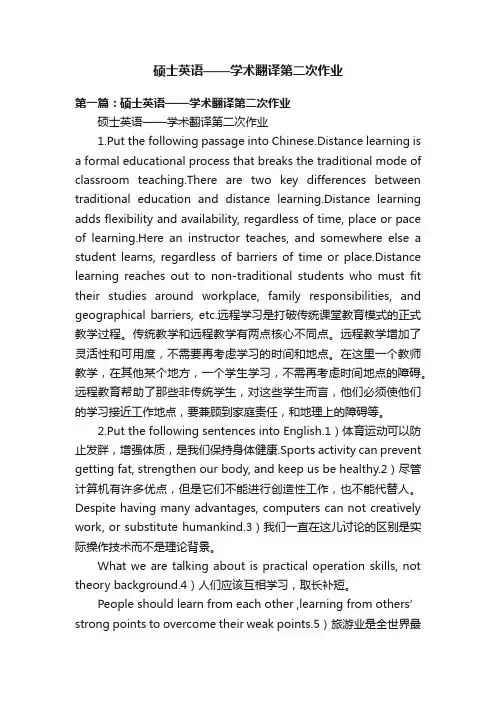
硕士英语——学术翻译第二次作业第一篇:硕士英语——学术翻译第二次作业硕士英语——学术翻译第二次作业1.Put the following passage into Chinese.Distance learning isa formal educational process that breaks the traditional mode of classroom teaching.There are two key differences between traditional education and distance learning.Distance learning adds flexibility and availability, regardless of time, place or pace of learning.Here an instructor teaches, and somewhere else a student learns, regardless of barriers of time or place.Distance learning reaches out to non-traditional students who must fit their studies around workplace, family responsibilities, and geographical barriers, etc.远程学习是打破传统课堂教育模式的正式教学过程。
传统教学和远程教学有两点核心不同点。
远程教学增加了灵活性和可用度,不需要再考虑学习的时间和地点。
在这里一个教师教学,在其他某个地方,一个学生学习,不需再考虑时间地点的障碍。
远程教育帮助了那些非传统学生,对这些学生而言,他们必须使他们的学习接近工作地点,要兼顾到家庭责任,和地理上的障碍等。
2.Put the following sentences into English.1)体育运动可以防止发胖,增强体质,是我们保持身体健康.Sports activity can prevent getting fat, strengthen our body, and keep us be healthy.2)尽管计算机有许多优点,但是它们不能进行创造性工作,也不能代替人。
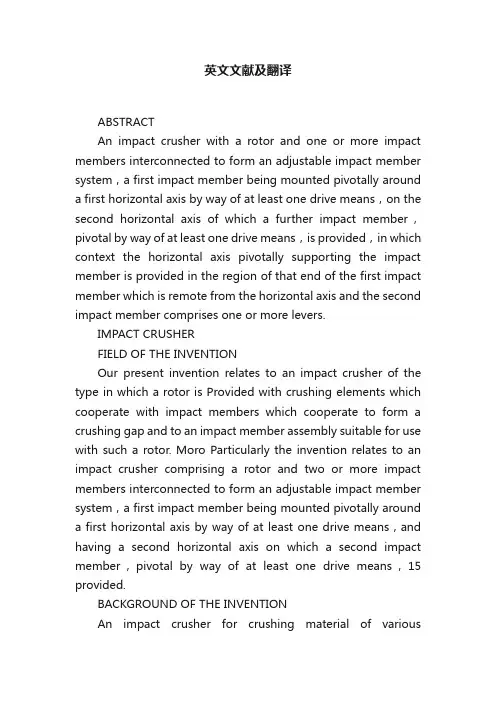
英文文献及翻译ABSTRACTAn impact crusher with a rotor and one or more impact members interconnected to form an adjustable impact member system,a first impact member being mounted pivotally around a first horizontal axis by way of at least one drive means,on the second horizontal axis of which a further impact member,pivotal by way of at least one drive means,is provided,in which context the horizontal axis pivotally supporting the impact member is provided in the region of that end of the first impact member which is remote from the horizontal axis and the second impact member comprises one or more levers.IMPACT CRUSHERFIELD OF THE INVENTIONOur present invention relates to an impact crusher of the type in which a rotor is Provided with crushing elements which cooperate with impact members which cooperate to form a crushing gap and to an impact member assembly suitable for use with such a rotor. Moro Particularly the invention relates to an impact crusher comprising a rotor and two or more impact members interconnected to form an adjustable impact member system,a first impact member being mounted pivotally around a first horizontal axis by way of at least one drive means,and having a second horizontal axis on which a second impact member,pivotal by way of at least one drive means,15 provided.BACKGROUND OF THE INVENTIONAn impact crusher for crushing material of variousconsistencies is known for example from DE 23 31 729 Al in which the impact plates are interconnected in articulated manner to form a coherent composite pivotal impact member,each of the interconnected impact plates deriving adjustable support individually from the housing. The impact plates may have impact surfaces which are at angles to one another or arc stepped along the path of the material as it 15 entrained from the inlet side of the machine.The principles of such machines have also been developed in the Chemical Engineers Handbook,Perry and Chilton,5th edition,McGraw Hill Book Company,New York,1973,at Chapters,pages 19 ff.This known impact crusher,just like impact other crushers of the same genus,suffers from the substantial drawback that the upper impact member,provided downstream of the machine inlet yields outwardly due to foreign objects which cannot be crushed entering the machine,so that the crushing gap between the rotor and the lower impact member is decreased to such an extent,due to the upper impact member pivoting outwardly,that a risk arises of foreign objects getting wedged between the rotor and the impact member,leading to possible damage to the rotor and/or the impact member,so that the continued operability of the installation can no longer be ensured.OBJECTS OF THE INVENTIONIt is the principal object of the present invention to provide an improved impact crusher such that the damage which can be caused by the entry of a noncrushable foreign object can be minimized. Another object of the invention is to provide an improved impact crusher which is free from the drawbacks ofearlier devices or apparatuses of this type and particularly the drawbacks mentioned above.Still another object of this invention is to provide improved impact assembly for a rotor-type crusher or breaker whereby drawbacks which could have resulted in down time can be avoided.SUMMARY OF THE INVENTIONThese objects are attained,in accordance with the invention in an impact crusher of the type in which a rotor and two or more impact members are provided along the path of the crusher members of the rotor to form an adjustable impact assembly. A first impact member is pivotally mounted at a firsthorizontal axis and a second impact member is pivotally mounted on the first impact member by a second horizontal.axis and respective drive means is provided for controlling the displacement of the impact members.According to the invention,the horizontal axis pivotally supporting the second impact member is provided in the 5 region of that end of the first impact member which is remote from the first horizontal axis and the second impact member comprises one or more levers.It is an important feature of the invention that due to the specific arrangement of the point of engagement for the 10 support and the point of articulation of the lower impact member to the lever,the crushing gap between the lower impact member and the rotor is enlarged in the event of the upper impact member yielding due to foreign object interference.Because of the geometrical relationships with regard to the cylinder hinge point and the axes of the impact members,theedge of the lower impact member closest to the rotor is moved automatically in such a manner during opening of the impact member, for which purpose a housing member is 20swibeled around the pivotal axis,that the edge does not collide with the rotor or the beater bars,thus preventing damage.Different drive means,preferably hydraulic cylinders,25 may be emp10yed in Order to adjust the two impact members.More particularly,the impact crusher can comprise:a housing; an impact crusher rotor rotatable in the housing about a horizontal rotor axis; and at least one impact member assembly in the housing adjustable relative to the rotor,the assembly including: a first impact member having impact surfaces juxtaposed with the rotor and pivotally mounted in the housing for movement about a first horizontal pivot axis to shift the surfaces toward and away from the rotor,a first drive means articulated to the first impact member for angularly displacing the first impact member about the first horizontal pivot axis,a second impact member having impact surfaces juxtaposed with the rotor and pivotally mounted in the housing for movement about a second horizontal pivot axis on the first impact member at a location remote from the first horizontal pivot axis to shift the surfaces of the second impact member toward and away from the rotor,at least one lever swingable about the second horizontal pivot axis and operatively connected with the second impact member for pivotally displacing same about the second horizontal pivot axis,and second drive means articulated to the lever for angularly displacing the second impact member about the second horizontal pivot axis.The impact crusher according to the invention is characterized by a particularly high operational reliability and,therefore,a particularly long useful life due to the advantageous arrangement of the point of engagement for the support of the lower impact member.BRIEF DESCRIPTION OF THE DRAWINGThe above and other objects,features,and advantages will become more readily apparent from the following description,reference being made to the accompanying drawing in which: FIG.1 is a diagrammatic transverse section through an impact crusher according to the invention; 5,890,666;FIG.IA is the impact crusher of FIG.1,shown with pivotal housing in open position;FIG.2 is a section taken along the line 2-2 of FIG.1;FIG.3 is a detail view of the connection of the levers with extensions of the second impact member.SPECIFIC DESCRIPTIONThe impact crusher illustrated in FIG.1 comprises a housing member 9 adapted to swing openaround a pivotalaxis 8 in order to open the impact crusher,and includes a rotor 10 adapted to be rotationally-driven,equipped with crushing elements,not shown in the drawing. Two impact members 1 and4,equipped with a multitude of impact elements 11 are provided in a manner facing the rotor 10.The impact member 1 disposed above the impact member 4,is pivotally mounted around a horizontal axis 2 by way of at least one cylinder 3 or a different drive element engaging in a hinge point 3a.Ai an end of the impact members in the region remote from the axis2,i.e. at a lower end,a further horizontal axis 6 is provided for pivotally mounting the impact member 4.The gap between the impact members l,4 and the rotor 10 can be denoted as crushing chute. The impact member 4comprises one or more levers 4a on which one or a plurality of cylinders 5 or other drive elements engages/engage at the associated hinge point 5a. The crushing gap 7 is formed by the impact member 4 and the rotor 10.The material to be crushed,reaching the impact crusher in the direction of the arrow 22,is pre-crushed in the upper region of the crusher and is further crushed by the upper impact member l,being finally crushed to the pre-set particle size by the lower impact member 4 in the crushing gap 7.From FIG.2,it will be apparent that two hydraulic cylinder drivers 5 are provided on each side of the impact member 1 and are connected to respective levers 4a and from FIG.3 it can be seen that each lever 4a which is rigid with the member 4 is on an extension 4b of that impact member to the respective side of the impact member 1.The impact surfaces of the impact members 1 and 4 are provided at 12 and 13 on the impact members and the pivot axis 8 for the housing part 9 carrying the axis 2 is so arranged with respect to the articulation points 5a and the axis 6 that,when the housing part 9 is swung open in the counterclockwise direction and the drives 3 and 5 are correspondingly actuated,there will be no collision between the impact members 1 and 4 and the rotor 10 or the crushing elements thereon.We claim:1.An impact crusher comprising: a housing; an impact crusher rotor rotatable in said housing about a horizontal rotor axis; and at least one impact member assembly in said housing adjustable relative to said rotor,said assembly including: a first impact member having impact surfaces juxta posed with said rotor and pivotally mounted in said housing for movement about a first horizontal pivot axis to shift said surfaces toward and awayfrom said rotor,a first drive means articulated to said first impact member for angularly displacing said first impact member about said first horizontal pivot axis,a second impact member having impact surfaces juxtaposed with said rotor and pivotally mounted in said housing for movement about a second horizontal pivot axis on said first impact member at a location remote from said first horizontal pivot axis to shift said surfaces of said second impact member toward and away from said rotor,lever means swingable about said second horizontal pivot axis and operatively connected with said second impact member for pivotally displacing same about said second horizontal pivot axis,and second drive means articulated to said lever for angularly displacing said second impact member about said second horizontal pivot axis,said lever means comprising a respective lever formed on said second impact member on extensions thereof along said 20 second horizontal pivot axis on opposite sides of said first impact member,each of said levers being pivotally connected with a respective second drive means at a respective articulation point.2.The impact crusher defined in claim 1 wherein said hinge points and said second horizontal axis being so located 25 so that,upon movement of said first impact member away from said rotor,a gap between said second impact member and said rotor increases.3.The impact crusher defined in claim 1 wherein said housing includes a movable housing part pivotally connected to a stationary housing part for opening of said crusher and said first axis is providedon said movable housing part.4.The impact crusher defined in claim 1 wherein saidhousing includes a movable housing part pivotally connected to a stationary housing part for opening of said crusher and said first horizontal axis is provided on said movable housing part,said points of articulation and Said second horizontal pivot axis being arranged relative to a pivot axis of movable horizontal Dart that collision between said second impact member with said rotor is precluded during opening of said crusher by swinging of said movable housing part.5.An impact assembly for an impact crusher having a rotor rotatable in a housing about a horizontal rotor axis,Said impact assembly cooperating with said rotor to form an adjustable crushing gap,said impact assembly including: a first impact member having impact surfaces juxtaposed with said rotor and pivotally mounted in said housing for movement about a first horizontal pivot axis to shift said surfaces toward and away from said rotor,a first drive means articulated to said first impact member for angularly displacing said first impact member about said first horizontal pivot axis,a second impact member having impact surfaces juxtaposed with said rotor and pivotally mounted in said housing for movement about a second horizontal pivot axis on said first impact member at a location remote from said first horizontal pivot axis to shift said surfaces of said second impact member toward and away from said rotor,lever means swingable about said second horizontal pivot axis and operatively connected with said second impact member for pivotally displacing same about said second horizontal pivot axis,and second drive means articulated to said lever for angularly displacing said second impact member about said second horizontal pivot axis,said lever means comprising a respectiVe lever formed on said second impact member on extensionsthereof along said second horizontal pivot axis on opposite sides of said first impact member,each of said levers being pivotally connected with a respective second drive means at a respective articulation point.6.The impact assembly defined in claim 5 wherein said hinge points and said second horizontal axis are located so that,upon movement of said first impact member away from said rotor,a gap between said second impact member and said rotor increases.摘要一个带有转子的撞击破碎单元还有一个或更多破碎单元互相连接而形成一个比较完整的破碎系统,一个第一个破碎单元通过至少一种调节方式很好的绕第一个水平轴线旋转,在第二水平轴线处另外一个破碎单元通过至少一种调节方式进行绕轴线旋转,这两种方式是通过支持碰撞构材的水平轴线来提供的,在第一个破碎单元的末端的区域内与水平桥线还有第二个破碎单元像个很大的距离。
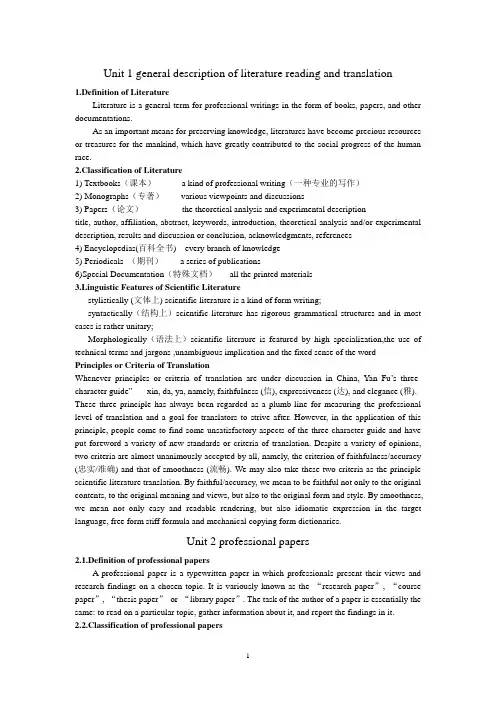
Unit 1 general description of literature reading and translation1.Definition of LiteratureLiterature is a general term for professional writings in the form of books, papers, and other documentations.As an important means for preserving knowledge, literatures have become precious resources or treasures for the mankind, which have greatly contributed to the social progress of the human race.2.Classification of Literature1) Textbooks(课本) a kind of professional writing(一种专业的写作)2) Monographs(专著) various viewpoints and discussions3) Papers(论文) the theoretical analysis and experimental descriptiontitle, author, affiliation, abstract, keywords, introduction, theoretical analysis and/or experimental description, results and discussion or conclusion, acknowledgments, references4) Encyclopedias(百科全书) every branch of knowledge5) Periodicals (期刊) a series of publications6)Special Documentation(特殊文档) all the printed materials3.Linguistic Features of Scientific Literaturestylistically (文体上) scientific literature is a kind of form writing;syntactically(结构上)scientific literature has rigorous grammatical structures and in most cases is rather unitary;Morphologically(语法上)scientific literaure is featured by high specialization,the use of technical terms and jargons ,unambiguous implication and the fixed sense of the wordPrinciples or Criteria of TranslationWhenever principles or criteria of translation are under discussion in China, Yan Fu’s three- character guide”-----xin, da, ya, namely, faithfulness (信), expressiveness (达), and elegance (雅). These three principle has always been regarded as a plumb-line for measuring the professional level of translation and a goal for translators to strive after. However, in the application of this principle, people come to find some unsatisfactory aspects of the three-character guide and have put foreword a variety of new standards or criteria of translation. Despite a variety of opinions, two criteria are almost unanimously accepted by all, namely, the criterion of faithfulness/accuracy (忠实/准确) and that of smoothness (流畅). We may also take these two criteria as the principle scientific literature translation. By faithful/accuracy, we mean to be faithful not only to the original contents, to the original meaning and views, but also to the original form and style. By smoothness, we mean not only easy and readable rendering, but also idiomatic expression in the target language, free form stiff formula and mechanical copying form dictionaries.Unit 2 professional papers2.1.Definition of professional papersA professional paper is a typewritten paper in which professionals present their views and research findings on a chosen topic. It is variously known as the “research paper”, “course paper”, “thesis paper” or “library paper”. The task of the author of a paper is essentially the same: to read on a particular topic, gather information about it, and report the findings in it.2.2.Classification of professional papers1)Report PaperThe report paper summarizes and reports the findings of another on a particular subject. The writer neither judges nor evaluates the findings, but merely catalogs them in a sensible sequence2) Research paperA research paper can be intelligent, well informed, interesting, and original in its conclusions.3) Course Papercourse papers are written after a specific course is learned or are designed at the end of a term. This type of paper is, therefore, also called “term paper”.4) Thesis Paperthe thesis paper takes a definite stand on an issue. A thesis is a proposition or point of view that a writer or speaker is willing to argue against or defend. A paper that argued for ratification of a certain event would therefore be a thesis paper. Writing a thesis paper requires a writer to exercise judgment, evaluate evidence, and construct a logical argument, whereas writing a report paper does not2.3. Linguistic Features of Professional PapersFormal Style: A professional paper deals with the study of some objective facts or problems, and the conclusion that is drawn should be based on relevant data, not on personal likes and dislikes. Specialized Terms:The terms in professional papers are typically specialized. Even in the same field, the meanings of the same word may vary slightly due to its different collections.Take the word “normal” as an example. Generally, it means “iEee”; but in mathematics, it represents “法线”; and in the field of chemistry, “当量” Again the word “power.” In electronics, it is rendered as “电力” or “电源”; in mechanics, “动力”; whereas in mathematics, “幂”Rigid Sentence Structure:The arguments in professional papers will be convincing if they are presented concisely and concretely. A rigid sentence structure is therefore reflected to meet this requirement.Formatted Elements:Though there are no set rules, a complete professional paper in its finished form usually has a regular format composed of the following elements: the title, author(s), affiliation(s), abstract, keywords, introduction, body of the paper (theoretical description including calculation, inference, reasoning, conclusion, etc. or experimental description including techniques, methods, materials, results and analysis, etc.), acknowledgments, appendices, references or bibliography, etc.Different meaning of story(1)This war is becoming the most important story of this generation. Event这场战争将成为这一代人经历的最重大的事件。
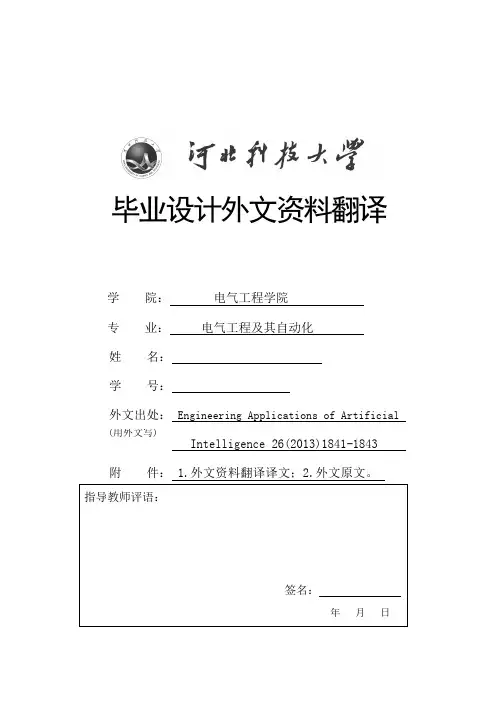
毕业设计外文资料翻译学院:电气工程学院专业:电气工程及其自动化姓名:学号:外文出处:Engineering Applications of ArtificialIntelligence 26(2013)1841-1843 附件: 1.外文资料翻译译文;2.外文原文。
(用外文写)附件1:外文资料翻译译文数据处理在智能网络中的智能分布:一种语义学研究方法摘要智能网络的远景不仅需要句法互操作以能够进行物理上的交换数据,还需要语义互操作以能够正确理解和解释它的意义。
随着全球统一的本体在智能电网场景中的应用,国际电工委员会和中国电力科学研究院支持计算机集成制造和国际电工委员会这两个广泛使用的工业标准的协调应用。
不过,坚持将如此巨大的通用本体应用到分布式系统的每一方面既不实际也不可行。
此外,智能电网将成为遗留的非均质砾岩和即将到来的架构,这将首先要求具备代表电网所有现存资产的可能性以及新的未知的东西,其次,为了协调复杂的活动,要求系统不同本体能够协调运作。
最后,智能电网提出了不同时间跨度的要求,例如实时性,并且所有问题必须有效解决,并且有节制的使用资源。
在此背景下,我们提出了一个遍布整个智能电网结构的智能节点框架。
每个智能节点只有全局本体的一个轮廓。
此外,加上自身推理,我们能够同时达到所需的智能分布和本地决策。
进一步讲,我们通过集成数据流处理工具在智能节电点内的应用,来满足上述提及的实时和准实时需求。
结合知识库概况和推理能力,我们的智能体系结构支持语义推理。
三个变电站以及涉及智能电网的许多不同实体的一些复杂活动的描述构成了一个原型系统,我们通过这个原型阐明了这种方法的可行性。
而且,我们也满足了统一本体的潜在拓展。
关键词:智能电网;语义互操作性;实时性处理;OWL本体1简介根据国家标准技术研究所和国际电工技术委员会,互操作性是关于智能电网的主要挑战之一。
这个事实基于以下历史因素:就供应商,数据标准,通信协议以及可能使用过的相关的软件结构而言,网络的组成是相当多样的,例如消息中间件,企业服务总线,面向服务架构,复杂事件处理,所有语义网络成分或数据采集与监控系统。
Part ONE :1.rate equations速率方程2.Coherence length相干长度3.Multi-hologram recording多全息记录4.Crosstalk串扰5.Electrooptic amplitude modulation 电光幅度调制6.Frequency spectrum频谱7.Dielectric constant介电常数8.Threshold value阈值9.Index of refraction折射率10.Quantum-Well Laser量子阱激光器11.DC current-voltage characteristics直流电流电压特性12.Gain coefficient增益系数13.Optical data storage光学数据存储14.Optoelectronics光电子学15.Transmission factor传输因子16.Phase modulation 相位调制17.Resonant circuit谐振电路18.Transit-Time 迁移时间19.Polarizer 起偏器20.retardation bias 延迟偏移21.Transverse electrooptic modulators横向电光调制器22.Traveling-wave modulators行波调制器23.Optical polarization光偏振24.Optical phase velocity光学相速度25.Crystal axis晶轴26.Modulated optical carrier调制光载波27.Propagation vector传播矢量28.V olume holograms体积全息照相29.Electrooptic crystal电光晶体30.Data-Bearing hologram数据方位全息图31.Object beam 物光32.Reference beam 参考光33.Incident beam 入射光34.Diffracted beam 衍射光35.Bragg diffraction布拉格衍射36.diffraction grating衍射光栅37.K space K空间38.Reconstruction 重构39.Wavelength multiplexing波长复用40.Diffraction efficiency衍射效率41.Reflection efficiency反射效率42.Demultiplexers分离器43.Dense wavelength division multiplexing密集波分复用44.Collimating lens准直透镜45.Coupling lens 耦合棱镜46.DFB分布反馈(激光器)47.Single mode fiber单模光纤48.Optical communication光通信49.Broadband access networks宽带接入网50.Passive optical networks无源光网络51.EPON 以太网无源光网络52.GPON 吉比特无源光网络53.A TM(Asynchronous Transfer Mode)异步传输模式54.ONT 光网络终端55.ONU 光网络单元56.FTTH光纤到户57.FTTB光纤到大楼58.FTTC光纤到路边59.Digital subscriber line数字用户线60.Hybrid fiber coaxial cable( HFC) 光纤同轴电缆混合网61.Optical line terminal(0LT) 光线路终端62.Optical distribution network(ODN) 光分配网络63.PSTN公用交换电话网64.Data encryption standard(DES) 数据加密标准65.Advanced encryption standard(AES) 高级加密标准66.Hybrid star-ring architecture混合星环结构67.Optical switch光开关68.EDFA掺铒光纤放大器69.Multi-point control protocol (MPCP) 多点控制协议70.Frequency spectrum 频谱71.CHAP(Challenge-Handshake Authentication Protocol)挑战握手协议72.Fiber Bragg grating sensor system光纤布拉格光栅传感系统73.SNR信噪比74.Microelectronics微电子75.Electro-fluidic microsystem modeling 电流体微系统模型76.Downstream traffic 下行通道77.Upstream traffic 上行通道78.Frame relay 帧中继79.Physical layer 物理层80.VHDL硬件描述语言81.Dynamic 动态的82.Digtal kernel 数字内核83.Splitter 分路器84.Transparency 幻灯片85.Photopolymer 光敏聚合物86.Dispersion 色散87.Bit rate 比特率88.Symmetric 对此89.Asymmetric 不对此90.Simultaneous simulation 实时仿真91.Mixed-signal 混合信号92.Multi-language simulation 多语言仿真93.Amplitude 振幅94.V alue boundaries 价带95.Virtual test 虚拟测试96.System-on-chip design系统级芯片设计97.Sub-system 子系统98.Analog kernel模拟内核99.Scatter 散射100.Feedback 反馈Part TWO:量子阱激光器的阻抗特性摘要:基于一个简单速率方程的模型,我们得出量子阱激光器阻抗在阈值附近的理论表达式。
文献、资料题目:学 专 班 姓 名: 张三学 号: 2010888888指导教师:翻译日期: ××××年××月××日临沂大学本科毕业论文外文文献及译文,the National Institute of Standards and Technology (NIST) has been working to develop a new encryption standard to keep government information secure .The organization is in the final stages of an open process of selecting one or more algorithms ,or data-scrambling formulas ,for the new Advanced Encryption Standard (AES) and plans to make adecision by late summer or early fall .The standard is slated to go into effect next year .AES is intended to be a stronger ,more efficient successor to Triple Data Encryption Standard (3DES),which replaced the aging DES ,which was cracked in less than three days in July 1998.“Until we have the AES ,3DES will still offer protection for years to come .So there is no need to immediately switch over ,”says Edward Roback , acting chief of the computer security division at NIST and chairman of the AES selection committee .“What AES will offer is a more efficient algorithm .It will be a federal standard ,but it will be widely implemented in the IT community .”According to Roback ,efficiency of the proposed algorithms is measured by how fast they can encrypt and decrypt information ,how fast they can present an encryption key and how much information they can encrypt .The AES review committee is also looking at how much space the algorithm takes up on a chip and how much memory it requires .Roback says the selection of a more efficient AES will also result in cost savings and better use of resources .“DES was desig ned for hardware implementations ,and we are now living in a world of much more efficient software ,and we have learned an awful lot about the design of algorithms ,”says Roback .“When you start multiplying this with the billions of implementations done daily ,the saving on overhead on the networks will be enormous .”……临沂大学本科毕业论文外文文献及译文- 2 -以确保政府的信息安全。
南京理工大学泰州科技学院
土木工程专业英语文献翻译
学院 (系): 土木工程学院
专 业: 土木工程
姓 名: 侯安阳
学 号: 0904060118
外文出处: China Ocean Eng Vol. 25
附 件: 1.外文资料翻译译文;
2.外文原文。
注:请将该封面与附件装订成册。
成绩:
签名:
年 月 日
Securingprivatewirelesssensorsinasharedenvironmentintheinternetofthingscontext
AnassRGHIOUI*1,SaidBOUCHKAREN2,AnassKHANNOUS1,MohammedBOUHORMA11LISTFSTT(LaboratoryofInformatics,SystemsandTelecommunications)
2LabTICENSAT(LaboratoryofTechnologyofInformationandCommunication)
AbdelmalekEssaadiUniversityTangier,Moroccoanass.rgh@gmail.com
Abstract—ToleadtotheSmartCities,weshouldhavethepossibilityofobtaininginformationfromdifferentplacesandobjectsanytimeandanywhere,inordertocollectsufficientdatatoanticipateproblemsandtakeagooddecisions.Thiswillpromotetoaneffectiveandautonomousorganizationbycreatinginteractedandcommunicatedobjectsaroundthecity.So,weneedtoinstallvariousandspecificIP-basedwirelesssensorseverywheretocollectdataremotelyandinarealtime.Theideaofmixingsensorsbelongingtoorganizationsfromdifferentspecialtiesinthesameplaceswillinvolveseveralexpertsandencouragescompetition.Butontheotherside,itwillopenthedoortonewsecuritythreatsandissues,alsothiswillimposenewmanagementproblemslikehowtolimittheaccesstoeachorganizationtoitssensors.Inthispaper,westudythesecurityofasetofIP-basedwirelesssensors,whichbelongstodifferentorganizations,andformalocalnetwork.Weproposeamodeltoensureexchangedinformationconfidentialityandmanagethesensorsaccessibility,whileconsideringthewirelesssensorsconstrainedcharacteristics.
Keywords—SmartCity;IEEE802.15.4;6LoWPAN;InternetofThings;IoT;WSN;NetworkSecurity.
I.INTRODUCTION
Withtheimmenseandrapiddevelopmentoftechnology,integratingdifferentdevicestotheinternetbecomespossible.Communicationinteractionaretransformedfromhuman-to-machinetomachine-to-machine(M2M),andmorespecificallythings-to-things,thatwhatcreatetheInternetofThings(IoT)[1].
Thistechnologyprogressfacilitatestheleadingofsmartcities[2],wheredifferentcohabitedobjectcancommunicateandinteracttodecideinsteadofhuman,ortohelpmanagerstomakemoreeffectivedecisions.Itsupportstheimprovementonmanylifeapplicationslikelogistic,healthcare,industry...etc.Mainlyformonitoringrequirementwherewemustusesensorsdevicestocapturedatainphysicalorenvironmentalconditions.
EnablingwirelesssensorsbasedontheIEEE802.15.4communicationprotocol[3],toconnecttotheinternetbyimplementingthemby6LoWPAN(IPv6overLowpowerWirelessAreaNetwork)technology[4],[5],givesthepossi-bilitytotransfersenseddatathroughthenetworkintheentireworld.6LoWPANwasdevelopedbyIETFasanadaptationlayerbetweennetworklayeranddatalinklayertopassIPv6packetof1260bytesinto802.15.4thatsupportonly127bytes
frames.Thissolutionallowstheuseofexistingresourceslikeinternetprotocolsandinfrastructure,andaddressingahugenumberofdevicessinceanIPv6addressis128bitslong,thisprovidesabout3.4x1038addressesmorethan667millionbillionaddressespersquaremillimeteroflandsurface.
InasmuchastheInternetofThingsisbasedonanopenarchitecture[6],andtheweakercharacteristicsofwirelesssen-sorsasresource-constraineddevices,securityissuesbecomesmoresensitive.Attackscancomefromtwosides:802.15.4sideandIPside[7].Anotherissueisthesecuritymanagementinthecaseofimplementingdifferentsensorsfromdifferentorganizationinthesameplace.Inanormalsituation,sensorsbelongingtothesameorganizationformalocalnetworkmanagedbyabasestation,butintheIoTcontext,togivetheopportunityforinterventionfromdifferentexpertsandencourageconcurrence,sensorsfromdifferentoriginsshouldbecohabitedinthesamelocalarea.
ThispaperprovidesasecuritymodelinthecontextofInter-netofThingstoensureconfidentialityandaccessmanagementofasetofIP-basedwirelesssensors,whichbelongstodifferentmanagementagenciesandformalocalnetwork.
Thestructureofthepaperisasfollows:Section2givesabriefoverviewofSmartCities,IoT,6LoWPANandIEEE802.15.4andtheirmainapplications,Section3reviewstheas-sumptionanddiscussestheissuesofourstudiedcasesecurity,Section4discussesthemodelforsecuringthenetworkwiththefocusonkeyestablishmentschemes,Section5presentsananalysisofourmodelintermsofenergy,flexibilityandsecurity.Finally,Section6concludesthepaper.
II.GENERALCONTEXTA.SmartCitiesprojectsSmartCityisasetofinterconnectedsystemscollaboratingtogetherandusingtechnologytoolsinordertoofferabettercitymanagementsystem.Usedtoolsareawholeofsmallcon-necteddevicesaccessedremotely.Interactionbetweenthemfacilitatecommunicationsandofferbettercoordination.Theyformaworkinggroupwithhugepossibilitiesinmonitoring,surveillance,andmanagementgivingrealtimedatatoman-agersandcitizenstoanticipateproblemsandhavesufficientinformationforbetterdecisions.
Mostofactorsinvolvedinsuchprojectsareindustrialsectorsofenergy,water,transport,telecomnetworkandin-